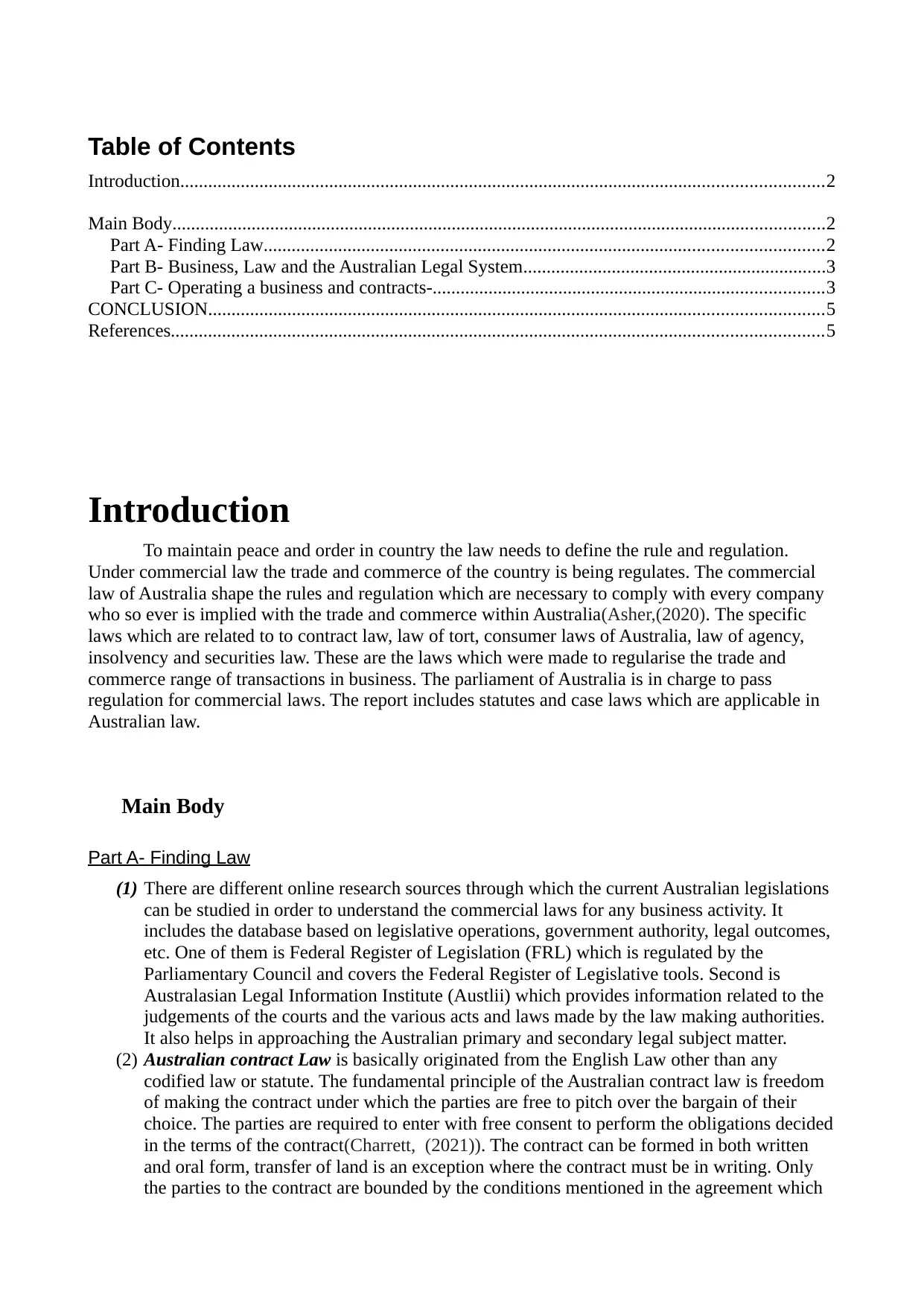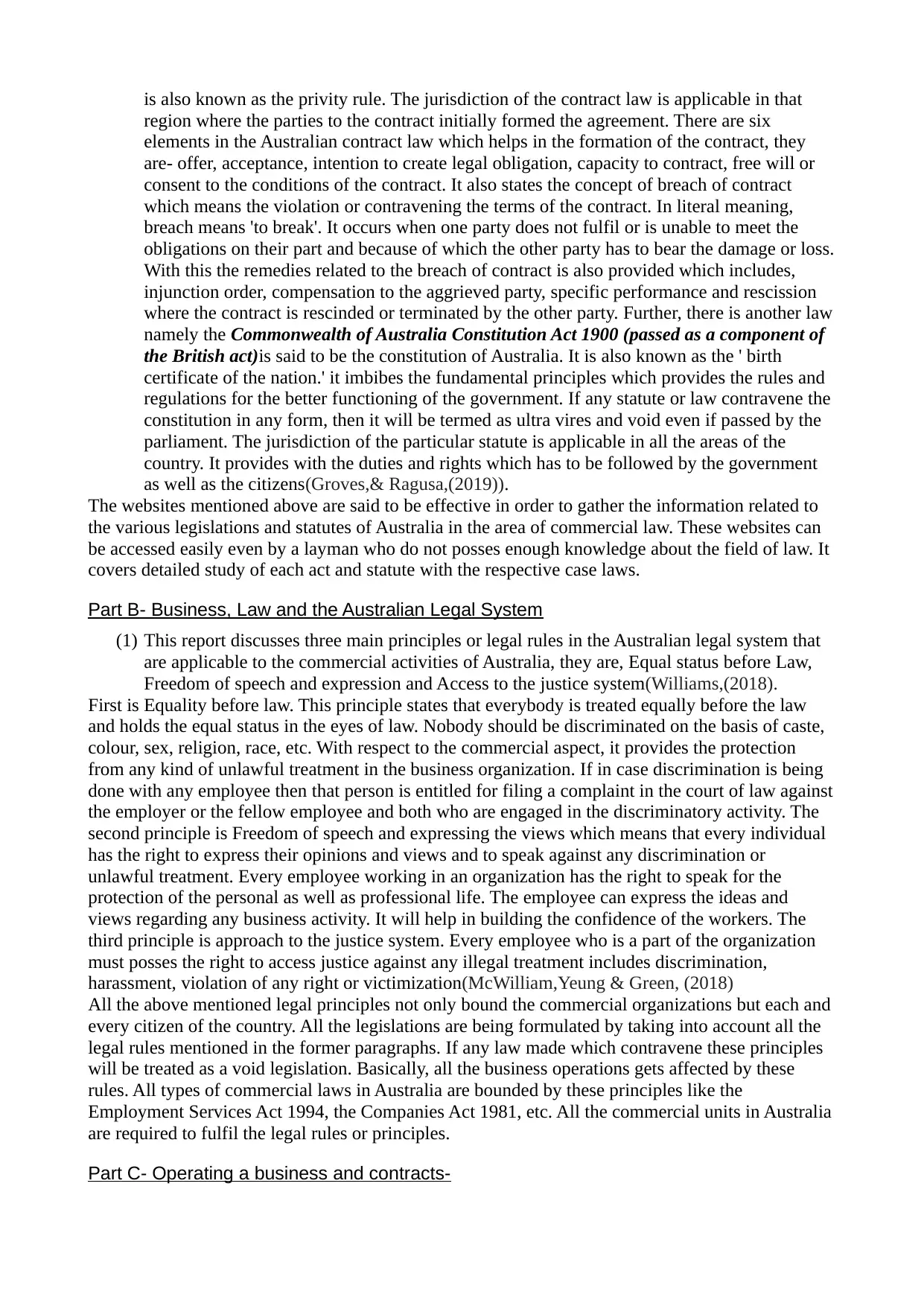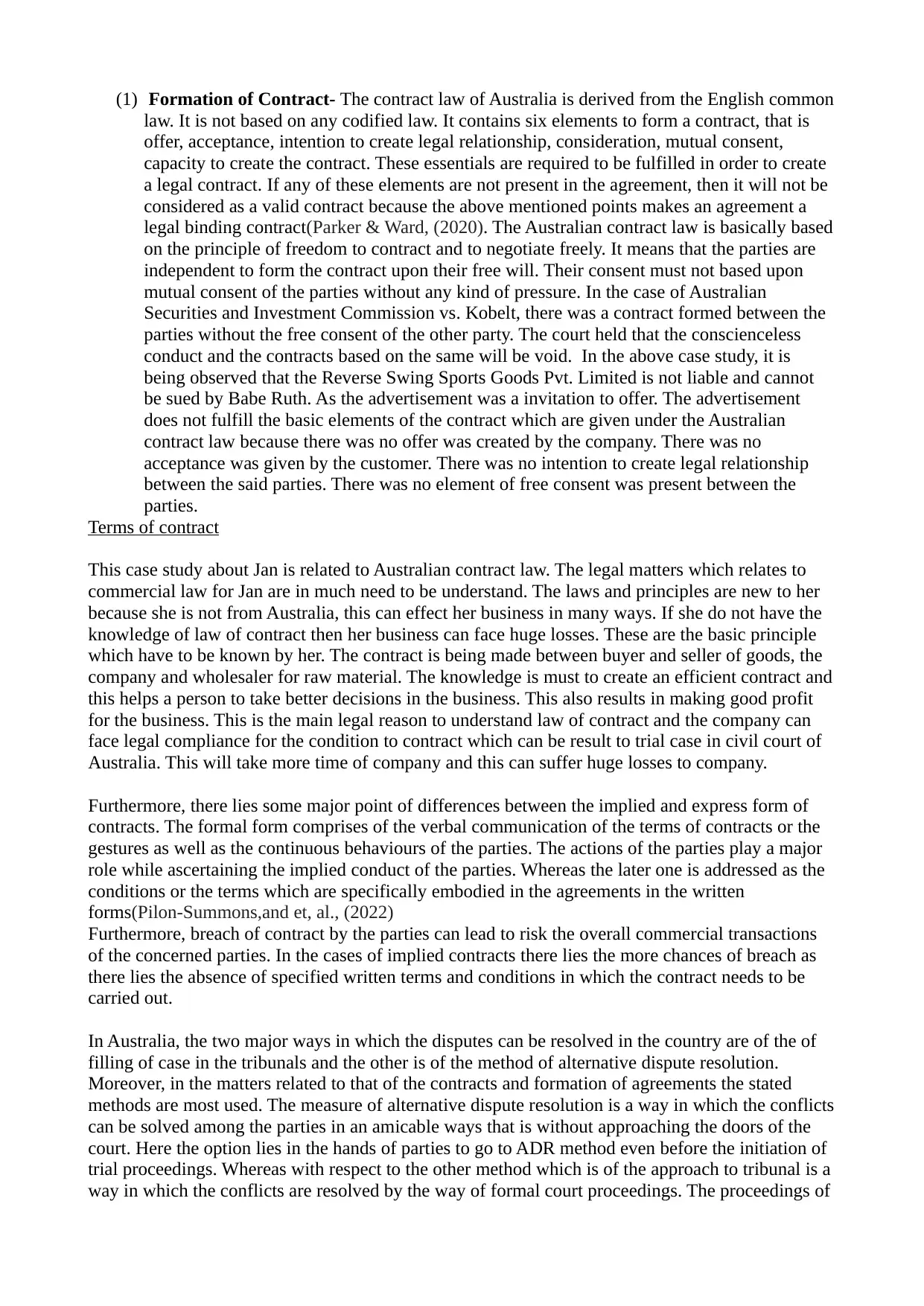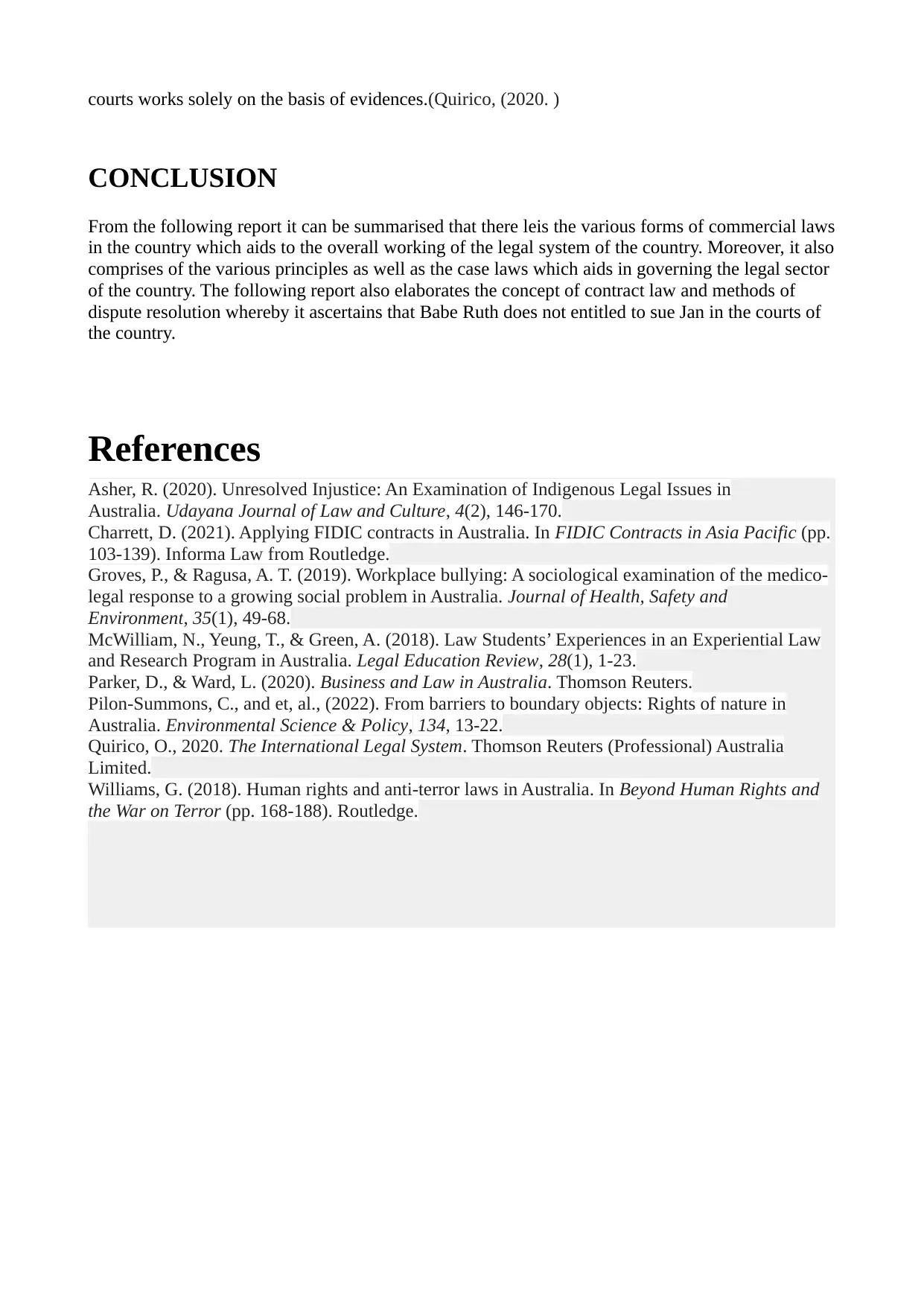Legal Framework for Australian Business: Operations and Contracts
VerifiedAdded on 2023/06/11
|5
|2438
|451
Report
AI Summary
This report provides an overview of Australian commercial law, focusing on the legal framework governing business operations and contracts. It examines key aspects such as finding relevant laws through online resources like the Federal Register of Legislation (FRL) and AustLII, and delves into the principles of Australian contract law, including offer, acceptance, and intention to create legal relations. The report also discusses fundamental legal principles within the Australian legal system, such as equality before the law, freedom of speech, and access to justice, and how these principles affect commercial activities. Furthermore, it analyzes contract formation, differentiating between express and implied contracts, and explores methods of dispute resolution. The report concludes that the Reverse Swing Sports Goods Pvt. Limited is not liable and cannot be sued by Babe Ruth, also Jan needs to understand the commercial law before starting business in Australia. The document is available on Desklib, a platform offering study tools and resources for students.

Individual project
Paraphrase This Document
Need a fresh take? Get an instant paraphrase of this document with our AI Paraphraser

Table of Contents
Introduction..........................................................................................................................................2
Main Body............................................................................................................................................2
Part A- Finding Law........................................................................................................................2
Part B- Business, Law and the Australian Legal System.................................................................3
Part C- Operating a business and contracts-....................................................................................3
CONCLUSION....................................................................................................................................5
References............................................................................................................................................5
Introduction
To maintain peace and order in country the law needs to define the rule and regulation.
Under commercial law the trade and commerce of the country is being regulates. The commercial
law of Australia shape the rules and regulation which are necessary to comply with every company
who so ever is implied with the trade and commerce within Australia(Asher,(2020). The specific
laws which are related to to contract law, law of tort, consumer laws of Australia, law of agency,
insolvency and securities law. These are the laws which were made to regularise the trade and
commerce range of transactions in business. The parliament of Australia is in charge to pass
regulation for commercial laws. The report includes statutes and case laws which are applicable in
Australian law.
Main Body
Part A- Finding Law
(1) There are different online research sources through which the current Australian legislations
can be studied in order to understand the commercial laws for any business activity. It
includes the database based on legislative operations, government authority, legal outcomes,
etc. One of them is Federal Register of Legislation (FRL) which is regulated by the
Parliamentary Council and covers the Federal Register of Legislative tools. Second is
Australasian Legal Information Institute (Austlii) which provides information related to the
judgements of the courts and the various acts and laws made by the law making authorities.
It also helps in approaching the Australian primary and secondary legal subject matter.
(2) Australian contract Law is basically originated from the English Law other than any
codified law or statute. The fundamental principle of the Australian contract law is freedom
of making the contract under which the parties are free to pitch over the bargain of their
choice. The parties are required to enter with free consent to perform the obligations decided
in the terms of the contract(Charrett, (2021)). The contract can be formed in both written
and oral form, transfer of land is an exception where the contract must be in writing. Only
the parties to the contract are bounded by the conditions mentioned in the agreement which
Introduction..........................................................................................................................................2
Main Body............................................................................................................................................2
Part A- Finding Law........................................................................................................................2
Part B- Business, Law and the Australian Legal System.................................................................3
Part C- Operating a business and contracts-....................................................................................3
CONCLUSION....................................................................................................................................5
References............................................................................................................................................5
Introduction
To maintain peace and order in country the law needs to define the rule and regulation.
Under commercial law the trade and commerce of the country is being regulates. The commercial
law of Australia shape the rules and regulation which are necessary to comply with every company
who so ever is implied with the trade and commerce within Australia(Asher,(2020). The specific
laws which are related to to contract law, law of tort, consumer laws of Australia, law of agency,
insolvency and securities law. These are the laws which were made to regularise the trade and
commerce range of transactions in business. The parliament of Australia is in charge to pass
regulation for commercial laws. The report includes statutes and case laws which are applicable in
Australian law.
Main Body
Part A- Finding Law
(1) There are different online research sources through which the current Australian legislations
can be studied in order to understand the commercial laws for any business activity. It
includes the database based on legislative operations, government authority, legal outcomes,
etc. One of them is Federal Register of Legislation (FRL) which is regulated by the
Parliamentary Council and covers the Federal Register of Legislative tools. Second is
Australasian Legal Information Institute (Austlii) which provides information related to the
judgements of the courts and the various acts and laws made by the law making authorities.
It also helps in approaching the Australian primary and secondary legal subject matter.
(2) Australian contract Law is basically originated from the English Law other than any
codified law or statute. The fundamental principle of the Australian contract law is freedom
of making the contract under which the parties are free to pitch over the bargain of their
choice. The parties are required to enter with free consent to perform the obligations decided
in the terms of the contract(Charrett, (2021)). The contract can be formed in both written
and oral form, transfer of land is an exception where the contract must be in writing. Only
the parties to the contract are bounded by the conditions mentioned in the agreement which

is also known as the privity rule. The jurisdiction of the contract law is applicable in that
region where the parties to the contract initially formed the agreement. There are six
elements in the Australian contract law which helps in the formation of the contract, they
are- offer, acceptance, intention to create legal obligation, capacity to contract, free will or
consent to the conditions of the contract. It also states the concept of breach of contract
which means the violation or contravening the terms of the contract. In literal meaning,
breach means 'to break'. It occurs when one party does not fulfil or is unable to meet the
obligations on their part and because of which the other party has to bear the damage or loss.
With this the remedies related to the breach of contract is also provided which includes,
injunction order, compensation to the aggrieved party, specific performance and rescission
where the contract is rescinded or terminated by the other party. Further, there is another law
namely the Commonwealth of Australia Constitution Act 1900 (passed as a component of
the British act)is said to be the constitution of Australia. It is also known as the ' birth
certificate of the nation.' it imbibes the fundamental principles which provides the rules and
regulations for the better functioning of the government. If any statute or law contravene the
constitution in any form, then it will be termed as ultra vires and void even if passed by the
parliament. The jurisdiction of the particular statute is applicable in all the areas of the
country. It provides with the duties and rights which has to be followed by the government
as well as the citizens(Groves,& Ragusa,(2019)).
The websites mentioned above are said to be effective in order to gather the information related to
the various legislations and statutes of Australia in the area of commercial law. These websites can
be accessed easily even by a layman who do not posses enough knowledge about the field of law. It
covers detailed study of each act and statute with the respective case laws.
Part B- Business, Law and the Australian Legal System
(1) This report discusses three main principles or legal rules in the Australian legal system that
are applicable to the commercial activities of Australia, they are, Equal status before Law,
Freedom of speech and expression and Access to the justice system(Williams,(2018).
First is Equality before law. This principle states that everybody is treated equally before the law
and holds the equal status in the eyes of law. Nobody should be discriminated on the basis of caste,
colour, sex, religion, race, etc. With respect to the commercial aspect, it provides the protection
from any kind of unlawful treatment in the business organization. If in case discrimination is being
done with any employee then that person is entitled for filing a complaint in the court of law against
the employer or the fellow employee and both who are engaged in the discriminatory activity. The
second principle is Freedom of speech and expressing the views which means that every individual
has the right to express their opinions and views and to speak against any discrimination or
unlawful treatment. Every employee working in an organization has the right to speak for the
protection of the personal as well as professional life. The employee can express the ideas and
views regarding any business activity. It will help in building the confidence of the workers. The
third principle is approach to the justice system. Every employee who is a part of the organization
must posses the right to access justice against any illegal treatment includes discrimination,
harassment, violation of any right or victimization(McWilliam,Yeung & Green, (2018)
All the above mentioned legal principles not only bound the commercial organizations but each and
every citizen of the country. All the legislations are being formulated by taking into account all the
legal rules mentioned in the former paragraphs. If any law made which contravene these principles
will be treated as a void legislation. Basically, all the business operations gets affected by these
rules. All types of commercial laws in Australia are bounded by these principles like the
Employment Services Act 1994, the Companies Act 1981, etc. All the commercial units in Australia
are required to fulfil the legal rules or principles.
Part C- Operating a business and contracts-
region where the parties to the contract initially formed the agreement. There are six
elements in the Australian contract law which helps in the formation of the contract, they
are- offer, acceptance, intention to create legal obligation, capacity to contract, free will or
consent to the conditions of the contract. It also states the concept of breach of contract
which means the violation or contravening the terms of the contract. In literal meaning,
breach means 'to break'. It occurs when one party does not fulfil or is unable to meet the
obligations on their part and because of which the other party has to bear the damage or loss.
With this the remedies related to the breach of contract is also provided which includes,
injunction order, compensation to the aggrieved party, specific performance and rescission
where the contract is rescinded or terminated by the other party. Further, there is another law
namely the Commonwealth of Australia Constitution Act 1900 (passed as a component of
the British act)is said to be the constitution of Australia. It is also known as the ' birth
certificate of the nation.' it imbibes the fundamental principles which provides the rules and
regulations for the better functioning of the government. If any statute or law contravene the
constitution in any form, then it will be termed as ultra vires and void even if passed by the
parliament. The jurisdiction of the particular statute is applicable in all the areas of the
country. It provides with the duties and rights which has to be followed by the government
as well as the citizens(Groves,& Ragusa,(2019)).
The websites mentioned above are said to be effective in order to gather the information related to
the various legislations and statutes of Australia in the area of commercial law. These websites can
be accessed easily even by a layman who do not posses enough knowledge about the field of law. It
covers detailed study of each act and statute with the respective case laws.
Part B- Business, Law and the Australian Legal System
(1) This report discusses three main principles or legal rules in the Australian legal system that
are applicable to the commercial activities of Australia, they are, Equal status before Law,
Freedom of speech and expression and Access to the justice system(Williams,(2018).
First is Equality before law. This principle states that everybody is treated equally before the law
and holds the equal status in the eyes of law. Nobody should be discriminated on the basis of caste,
colour, sex, religion, race, etc. With respect to the commercial aspect, it provides the protection
from any kind of unlawful treatment in the business organization. If in case discrimination is being
done with any employee then that person is entitled for filing a complaint in the court of law against
the employer or the fellow employee and both who are engaged in the discriminatory activity. The
second principle is Freedom of speech and expressing the views which means that every individual
has the right to express their opinions and views and to speak against any discrimination or
unlawful treatment. Every employee working in an organization has the right to speak for the
protection of the personal as well as professional life. The employee can express the ideas and
views regarding any business activity. It will help in building the confidence of the workers. The
third principle is approach to the justice system. Every employee who is a part of the organization
must posses the right to access justice against any illegal treatment includes discrimination,
harassment, violation of any right or victimization(McWilliam,Yeung & Green, (2018)
All the above mentioned legal principles not only bound the commercial organizations but each and
every citizen of the country. All the legislations are being formulated by taking into account all the
legal rules mentioned in the former paragraphs. If any law made which contravene these principles
will be treated as a void legislation. Basically, all the business operations gets affected by these
rules. All types of commercial laws in Australia are bounded by these principles like the
Employment Services Act 1994, the Companies Act 1981, etc. All the commercial units in Australia
are required to fulfil the legal rules or principles.
Part C- Operating a business and contracts-
⊘ This is a preview!⊘
Do you want full access?
Subscribe today to unlock all pages.

Trusted by 1+ million students worldwide

(1) Formation of Contract- The contract law of Australia is derived from the English common
law. It is not based on any codified law. It contains six elements to form a contract, that is
offer, acceptance, intention to create legal relationship, consideration, mutual consent,
capacity to create the contract. These essentials are required to be fulfilled in order to create
a legal contract. If any of these elements are not present in the agreement, then it will not be
considered as a valid contract because the above mentioned points makes an agreement a
legal binding contract(Parker & Ward, (2020). The Australian contract law is basically based
on the principle of freedom to contract and to negotiate freely. It means that the parties are
independent to form the contract upon their free will. Their consent must not based upon
mutual consent of the parties without any kind of pressure. In the case of Australian
Securities and Investment Commission vs. Kobelt, there was a contract formed between the
parties without the free consent of the other party. The court held that the conscienceless
conduct and the contracts based on the same will be void. In the above case study, it is
being observed that the Reverse Swing Sports Goods Pvt. Limited is not liable and cannot
be sued by Babe Ruth. As the advertisement was a invitation to offer. The advertisement
does not fulfill the basic elements of the contract which are given under the Australian
contract law because there was no offer was created by the company. There was no
acceptance was given by the customer. There was no intention to create legal relationship
between the said parties. There was no element of free consent was present between the
parties.
Terms of contract
This case study about Jan is related to Australian contract law. The legal matters which relates to
commercial law for Jan are in much need to be understand. The laws and principles are new to her
because she is not from Australia, this can effect her business in many ways. If she do not have the
knowledge of law of contract then her business can face huge losses. These are the basic principle
which have to be known by her. The contract is being made between buyer and seller of goods, the
company and wholesaler for raw material. The knowledge is must to create an efficient contract and
this helps a person to take better decisions in the business. This also results in making good profit
for the business. This is the main legal reason to understand law of contract and the company can
face legal compliance for the condition to contract which can be result to trial case in civil court of
Australia. This will take more time of company and this can suffer huge losses to company.
Furthermore, there lies some major point of differences between the implied and express form of
contracts. The formal form comprises of the verbal communication of the terms of contracts or the
gestures as well as the continuous behaviours of the parties. The actions of the parties play a major
role while ascertaining the implied conduct of the parties. Whereas the later one is addressed as the
conditions or the terms which are specifically embodied in the agreements in the written
forms(Pilon-Summons,and et, al., (2022)
Furthermore, breach of contract by the parties can lead to risk the overall commercial transactions
of the concerned parties. In the cases of implied contracts there lies the more chances of breach as
there lies the absence of specified written terms and conditions in which the contract needs to be
carried out.
In Australia, the two major ways in which the disputes can be resolved in the country are of the of
filling of case in the tribunals and the other is of the method of alternative dispute resolution.
Moreover, in the matters related to that of the contracts and formation of agreements the stated
methods are most used. The measure of alternative dispute resolution is a way in which the conflicts
can be solved among the parties in an amicable ways that is without approaching the doors of the
court. Here the option lies in the hands of parties to go to ADR method even before the initiation of
trial proceedings. Whereas with respect to the other method which is of the approach to tribunal is a
way in which the conflicts are resolved by the way of formal court proceedings. The proceedings of
law. It is not based on any codified law. It contains six elements to form a contract, that is
offer, acceptance, intention to create legal relationship, consideration, mutual consent,
capacity to create the contract. These essentials are required to be fulfilled in order to create
a legal contract. If any of these elements are not present in the agreement, then it will not be
considered as a valid contract because the above mentioned points makes an agreement a
legal binding contract(Parker & Ward, (2020). The Australian contract law is basically based
on the principle of freedom to contract and to negotiate freely. It means that the parties are
independent to form the contract upon their free will. Their consent must not based upon
mutual consent of the parties without any kind of pressure. In the case of Australian
Securities and Investment Commission vs. Kobelt, there was a contract formed between the
parties without the free consent of the other party. The court held that the conscienceless
conduct and the contracts based on the same will be void. In the above case study, it is
being observed that the Reverse Swing Sports Goods Pvt. Limited is not liable and cannot
be sued by Babe Ruth. As the advertisement was a invitation to offer. The advertisement
does not fulfill the basic elements of the contract which are given under the Australian
contract law because there was no offer was created by the company. There was no
acceptance was given by the customer. There was no intention to create legal relationship
between the said parties. There was no element of free consent was present between the
parties.
Terms of contract
This case study about Jan is related to Australian contract law. The legal matters which relates to
commercial law for Jan are in much need to be understand. The laws and principles are new to her
because she is not from Australia, this can effect her business in many ways. If she do not have the
knowledge of law of contract then her business can face huge losses. These are the basic principle
which have to be known by her. The contract is being made between buyer and seller of goods, the
company and wholesaler for raw material. The knowledge is must to create an efficient contract and
this helps a person to take better decisions in the business. This also results in making good profit
for the business. This is the main legal reason to understand law of contract and the company can
face legal compliance for the condition to contract which can be result to trial case in civil court of
Australia. This will take more time of company and this can suffer huge losses to company.
Furthermore, there lies some major point of differences between the implied and express form of
contracts. The formal form comprises of the verbal communication of the terms of contracts or the
gestures as well as the continuous behaviours of the parties. The actions of the parties play a major
role while ascertaining the implied conduct of the parties. Whereas the later one is addressed as the
conditions or the terms which are specifically embodied in the agreements in the written
forms(Pilon-Summons,and et, al., (2022)
Furthermore, breach of contract by the parties can lead to risk the overall commercial transactions
of the concerned parties. In the cases of implied contracts there lies the more chances of breach as
there lies the absence of specified written terms and conditions in which the contract needs to be
carried out.
In Australia, the two major ways in which the disputes can be resolved in the country are of the of
filling of case in the tribunals and the other is of the method of alternative dispute resolution.
Moreover, in the matters related to that of the contracts and formation of agreements the stated
methods are most used. The measure of alternative dispute resolution is a way in which the conflicts
can be solved among the parties in an amicable ways that is without approaching the doors of the
court. Here the option lies in the hands of parties to go to ADR method even before the initiation of
trial proceedings. Whereas with respect to the other method which is of the approach to tribunal is a
way in which the conflicts are resolved by the way of formal court proceedings. The proceedings of
Paraphrase This Document
Need a fresh take? Get an instant paraphrase of this document with our AI Paraphraser

courts works solely on the basis of evidences.(Quirico, (2020. )
CONCLUSION
From the following report it can be summarised that there leis the various forms of commercial laws
in the country which aids to the overall working of the legal system of the country. Moreover, it also
comprises of the various principles as well as the case laws which aids in governing the legal sector
of the country. The following report also elaborates the concept of contract law and methods of
dispute resolution whereby it ascertains that Babe Ruth does not entitled to sue Jan in the courts of
the country.
References
Asher, R. (2020). Unresolved Injustice: An Examination of Indigenous Legal Issues in
Australia. Udayana Journal of Law and Culture, 4(2), 146-170.
Charrett, D. (2021). Applying FIDIC contracts in Australia. In FIDIC Contracts in Asia Pacific (pp.
103-139). Informa Law from Routledge.
Groves, P., & Ragusa, A. T. (2019). Workplace bullying: A sociological examination of the medico-
legal response to a growing social problem in Australia. Journal of Health, Safety and
Environment, 35(1), 49-68.
McWilliam, N., Yeung, T., & Green, A. (2018). Law Students’ Experiences in an Experiential Law
and Research Program in Australia. Legal Education Review, 28(1), 1-23.
Parker, D., & Ward, L. (2020). Business and Law in Australia. Thomson Reuters.
Pilon-Summons, C., and et, al., (2022). From barriers to boundary objects: Rights of nature in
Australia. Environmental Science & Policy, 134, 13-22.
Quirico, O., 2020. The International Legal System. Thomson Reuters (Professional) Australia
Limited.
Williams, G. (2018). Human rights and anti-terror laws in Australia. In Beyond Human Rights and
the War on Terror (pp. 168-188). Routledge.
CONCLUSION
From the following report it can be summarised that there leis the various forms of commercial laws
in the country which aids to the overall working of the legal system of the country. Moreover, it also
comprises of the various principles as well as the case laws which aids in governing the legal sector
of the country. The following report also elaborates the concept of contract law and methods of
dispute resolution whereby it ascertains that Babe Ruth does not entitled to sue Jan in the courts of
the country.
References
Asher, R. (2020). Unresolved Injustice: An Examination of Indigenous Legal Issues in
Australia. Udayana Journal of Law and Culture, 4(2), 146-170.
Charrett, D. (2021). Applying FIDIC contracts in Australia. In FIDIC Contracts in Asia Pacific (pp.
103-139). Informa Law from Routledge.
Groves, P., & Ragusa, A. T. (2019). Workplace bullying: A sociological examination of the medico-
legal response to a growing social problem in Australia. Journal of Health, Safety and
Environment, 35(1), 49-68.
McWilliam, N., Yeung, T., & Green, A. (2018). Law Students’ Experiences in an Experiential Law
and Research Program in Australia. Legal Education Review, 28(1), 1-23.
Parker, D., & Ward, L. (2020). Business and Law in Australia. Thomson Reuters.
Pilon-Summons, C., and et, al., (2022). From barriers to boundary objects: Rights of nature in
Australia. Environmental Science & Policy, 134, 13-22.
Quirico, O., 2020. The International Legal System. Thomson Reuters (Professional) Australia
Limited.
Williams, G. (2018). Human rights and anti-terror laws in Australia. In Beyond Human Rights and
the War on Terror (pp. 168-188). Routledge.
1 out of 5
Related Documents
Your All-in-One AI-Powered Toolkit for Academic Success.
+13062052269
info@desklib.com
Available 24*7 on WhatsApp / Email
![[object Object]](/_next/static/media/star-bottom.7253800d.svg)
Unlock your academic potential
Copyright © 2020–2025 A2Z Services. All Rights Reserved. Developed and managed by ZUCOL.

